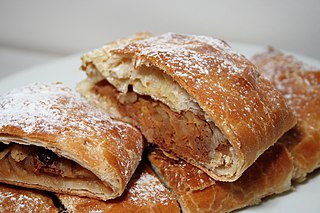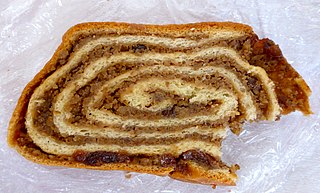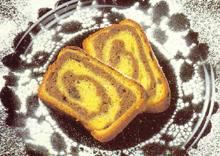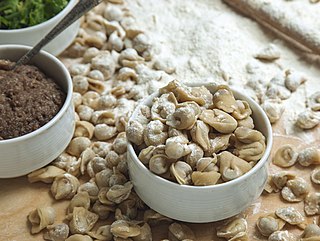
An empanada is a type of baked or fried turnover consisting of pastry and filling, common in Spanish, other Southern European, Latin American, and Iberian-influenced cultures around the world. The name comes from the Spanish empanar, and translates as 'breaded', that is, wrapped or coated in bread. They are made by folding dough over a filling, which may consist of meat, cheese, tomato, corn, or other ingredients, and then cooking the resulting turnover, either by baking or frying.

Apple strudel is a traditional Viennese strudel, a popular pastry in Austria, Bavaria, the Czech Republic, Northern Italy, Slovenia, and other countries in Europe that once belonged to the Austro-Hungarian Empire (1867–1918).

White Carniola is a traditional region in southeastern Slovenia on the border with Croatia. Due to its smallness, it is often considered a subunit of the broader Lower Carniola region, although with distinctive cultural, linguistic, and historical features.

A hamantash is an Ashkenazi Jewish triangular filled-pocket pastry, associated with the Jewish holiday of Purim. The name refers to Haman, the villain in the Purim story. In Hebrew, hamantashen are also known as אוזני המן meaning "Haman's ears". "Haman's ears" also refers to a Sephardic Purim pastry, "Orejas de Haman", thought to originate in Spain and Italy, that is made by frying twisted or rolled strips of dough.

A strudel is a type of layered pastry with a filling that is usually sweet, but savoury fillings are also common. It became popular in the 18th century throughout the Habsburg Empire. Strudel is part of Austrian cuisine but is also common in other Central European cuisines. In Italy it is recognized as a traditional agri-food product (PAT) of South Tyrol.

Börek or burek are a family of pastries or pies found in the Balkans, Middle East and Central Asia. The pastry is made of a thin flaky dough such as filo with a variety of fillings, such as meat, cheese, spinach or potatoes. Boreks are mainly associated with Anatolia, the Middle East, Armenia, and also with the former Ottoman Empire, including the Balkans and the Caucasus, Eastern European and Central European countries, Northern Africa and Central Asia. A borek may be prepared in a large pan and cut into portions after baking, or as individual pastries. They are usually baked but some varieties can be fried. Borek is sometimes sprinkled with sesame or nigella seeds, and it can be served hot or cold.

Gibanica is a traditional pastry dish popular all over the Balkans. It is usually made with cottage cheese and eggs. Recipes can range from sweet to savoury, and from simple to festive and elaborate multi-layered cakes.

Slovenian potica is a nut roll and a traditional festive pastry from Slovenia.

A nut roll is a pastry consisting of a sweet yeast dough that is rolled out very thin, spread with a nut paste made from ground nuts and a sweetener like honey, then rolled up into a log shape. This 'log' is either left long and straight or is often bent into a horseshoe shape, egg washed, baked, and then sliced crosswise. Nut rolls resemble a jelly roll but usually with more layers of dough and filling, and resemble strudels but with fewer and less delicate dough layers. Fillings commonly have as their main ingredient ground walnuts or poppy seeds.

Nogometni klub Bela Krajina, commonly referred to as NK Bela Krajina, was a Slovenian football club which played in the town of Črnomelj, White Carniola.

Slovenian cuisine is influenced by the diversity of Slovenia's landscape, climate, history and neighbouring cultures. In 2016, the leading Slovenian ethnologists divided the country into 24 gastronomic regions. The first Slovene-language cookbook was published by Valentin Vodnik in 1798.

The poppy seed roll is a pastry consisting of a roll of sweet yeast bread with a dense, rich, bittersweet filling of poppy seed. An alternative filling is a paste of minced walnuts, or minced chestnuts.

Štruklji are a traditional Slovene dish, composed of dough and various types of filling. The dish comes in the form of rolls, which can be either cooked or baked, and can have a wide range of fillings. Štruklji has been traditionally reserved for special occasions, but is now one of the most characteristic everyday dishes in households all across Slovenia. It is closely related to Zagorski štrukli, a traditional Croatian dish.

Dumpling is a broad class of dishes that consist of pieces of dough, oftentimes wrapped around a filling. The dough can be based on bread, flour, buckwheat or potatoes, and may be filled with meat, fish, tofu, cheese, vegetables, fruits or sweets. Dumplings may be prepared using a variety of methods, including baking, boiling, frying, simmering or steaming and are found in many world cuisines. In the United States in May 2015 National Day Calendar listed National Dumpling Day as held on September 26, annually.

Poğaça is a type of bread baked in the ashes of the fireplace, and later on in the oven, similar to focaccia. Found in the cuisines of the Balkans, it can be leavened or unleavened, though the latter is considered more challenging to make. It is generally made from wheat flour, but barley and sometimes rye may be added. It can be stuffed with potatoes, ground beef, or cheese, and have grains and herbs like sesame, black nigella seed, or dried dill in the dough or sprinkled on top.

Joshpara is a kind of dumpling popular in Central Asia, South Caucasus and the Middle East. They are made of unleavened wheat dough squares filled with ground meat and condiments. In observance of the Islamic dietary rules, the meat filling is usually without pork.

A babka is a sweet braided bread which originated in the Jewish communities of Poland and Ukraine. It is popular in Israel and in the Jewish diaspora. It is prepared with a yeast-leavened dough that is rolled out and spread with a filling such as chocolate, cinnamon, fruit, or cheese, then rolled up and braided before baking.















